Wednesday, September 27, 2006
The great honey robbery
September 24; harvest day, or as vegan's would call it, the day we steal the bees' winter food.
We remove the two supers. The bees gorge themselves on additional honey comb they have made on top of the queen excluder.
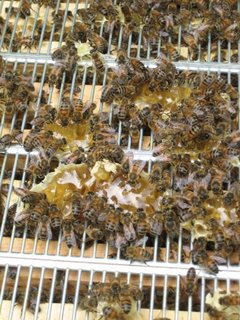
This is the first super, containing honey
produced during the July heatwave.
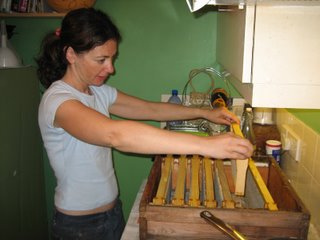
Out attempts to borrow a centrifuge failed. So instead of buying one for £200 we decided to harvest by hand. This entails scraping off the waxy bits and the honey from all frames. It's time consuming...
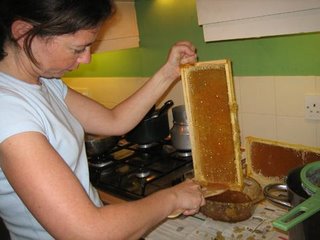
The waxy bits contain some honey so we put it all through a sieve.
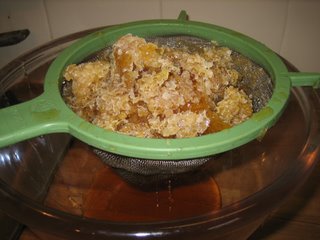
and messy....
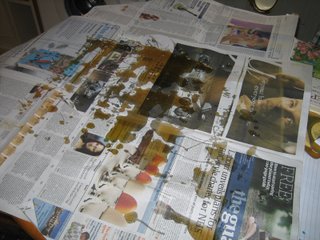
But very rewarding when we discovered that we
had around 5 kilos of dark, rich mixture to pour
into our 110 gram jars.


We're going to run out of jars...
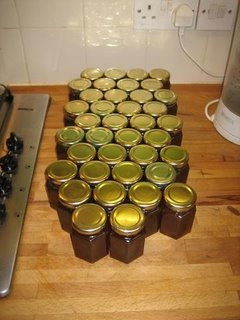
We then have to do it all again with the frames in the second super.
You'll be able to see, when we put these photos up, that the honey is a much lighter colour.
This honey - about 4 kilos - was produced by the bees during August and September.
As well as looking different, it tastes completely different. It has a much more delicate flavour with a strong hint of lime. Since we were told the bees at this time of year probably feed on lime trees - of which there are many in London - this is not surprising.
We fill our 50 small jars with the two types of honey to be given away to friends and family. We fill a few larger jars for ourselves.
We return the empty frames and any containing uncapped honey to the bees in the supers. They will wipe the frames clean of all traces of honey in the next week and will then be ready for wintering.
We remove the two supers. The bees gorge themselves on additional honey comb they have made on top of the queen excluder.

This is the first super, containing honey
produced during the July heatwave.

Out attempts to borrow a centrifuge failed. So instead of buying one for £200 we decided to harvest by hand. This entails scraping off the waxy bits and the honey from all frames. It's time consuming...

The waxy bits contain some honey so we put it all through a sieve.

and messy....

But very rewarding when we discovered that we
had around 5 kilos of dark, rich mixture to pour
into our 110 gram jars.


We're going to run out of jars...

We then have to do it all again with the frames in the second super.
You'll be able to see, when we put these photos up, that the honey is a much lighter colour.
This honey - about 4 kilos - was produced by the bees during August and September.
As well as looking different, it tastes completely different. It has a much more delicate flavour with a strong hint of lime. Since we were told the bees at this time of year probably feed on lime trees - of which there are many in London - this is not surprising.
We fill our 50 small jars with the two types of honey to be given away to friends and family. We fill a few larger jars for ourselves.
We return the empty frames and any containing uncapped honey to the bees in the supers. They will wipe the frames clean of all traces of honey in the next week and will then be ready for wintering.